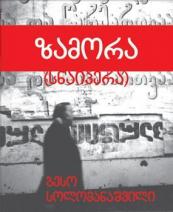The story Zamora is a mini-saga about the family of a Spanish toreador, Manuel Zamora. The toreador is an opponent and, in fact, a victim of the dictator Franco Baamonde; his wife and child have managed to flee to Soviet Georgia, their last descendant, however, the little Manuel Zamora, is killed in the Georgian-Abkhaz war; he was a well-know sniper, but a hard drug addict and sacrificed himself. This is the story of a children of war, about the war adventures of four friends in love with the same woman, of the part played by good, juicy food, of revolution and of a story of the significance of penis length… It is about Gagarin, about Khrushchiov, about the KGB agents and a Georgian officer, about an ignorant peasant who doesn’t give a damn about his homeland’s freedom, about women in wartime. This is the story of a closed circle in which people and history are tied to one another.
The story The Airy Plane is set after the second world war, in a very beautiful high mountain part of Georgian, Tusheti: communists have take two German prisoners, engineers, to build a bridge over a mountain river . The small military aircraft which takes the prisoners is seen for the first time by the Tush shepherd Gabbro, who is amazed and scared and, judging by the pictures he sees in a book which the pilot gives him, carves himself an aeroplane from wood and tries to flee. He can’t take off, but something big has resulted as a result of this plane with the bridge over the river Alas an, which the German prisoners are unable to build. The dream of the Tush shepherd is better than what the German prisoner-engineers can carve out. This is a story of the echoes of great world events on a little village, when Yachaghi, who has gone to the forest to seek justice, like the good hero of a fairy-tale, and the Bolshevik commandant is like an evil demon, the shepherd protector of the church shrine proves superior to the communist leaders. One German prisoner, in love with a Tush woman, saves the whole of Tusheti with his photographs… All this is based on an utterly true story, and it also ends well.
The story
The Gibbon is about a man who loves his country, but has a very strange concept of patriotism. He becomes stubborn and behaves like Don Quixote. He has his own philosophy and, because of the way he looks, is nicknamed the ‘gibbon’. On one occasion he fights with a sword in single combat with occupiers of his ancestral homeland: even though it is the end of the twentieth century and everyone has an automatic gun, he persists in fighting with a sword. He has fought so much that he now sits, angry with the entire world, half crippled, working in a museum, so that he can look after the museum pieces that have been left by his ancestors. This is the story of a man lost in history, of the way in which the world cannot endure sincere people.
‘Beso Solomanashvili’s skills have been honed by his links with representing factual material. For one thing, the writer has a good knowledge of the atmosphere of a totalitarian state, its actual realities, characteristics, ways of expression. ‘Alexander’s Life’ (just like the Zamoras’) is forged by the peripateias of an authoritarian regime which has crippled the lives of thousands of people. Moreover, from the start the author adds intonations and form to the narrative that help us to perceive effortlessly and convincingly even the roughest events in life, the harshest features.’
Literature in Hot Chocolate
‘Beso Solomanashvili knows one thing: he sets out his material about life in an utterly individual narrative way: here the narrator’s subjectivity is fused with inexplicable and strange facts of reality and the result is a strange symbiosis…’
Andro Buachidze, writer, critic
Extract will be available soon
In case of using the information, please, indicate the source.
